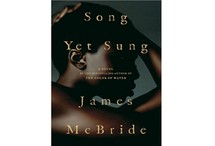Song Yet Sung
By James McBride
368 pages;
Riverhead
"Chance is an instrument of God," the No Name woman tells Liz Spocott, the beautiful, twice-escaped slave at the center of James McBride's second novel, Song Yet Sung (Riverhead). "And the coach wrench turns the wagon wheel.... Scratch a line in the dirt to make a friend.... Use double wedding rings when you marry. Tie the wedding knot five times. And remember, it's not the song, but the singer of it. You got to sing the second part twice." Liz doesn't at first understand the meaning of the Code given to her by the No Name woman just before she dies, but she feels the import of the words.
The year is 1850, and on Maryland's Eastern Shore the woods, swamps, and waterways are alive with the movements of runaway slaves—who can sense the freedom that awaits them only 80 miles north across the Pennsylvania state line—and the slave catchers hired to return them to their owners. These Chesapeake backwaters are also home to the watermen: poor, tough, fiercely independent blacks and whites, generations of oystermen who sometimes ferry runaways to safety; and to Woolman, an escaped slave who has avoided capture for years by learning to run like an animal and stand still as a tree; and to the volatile Patty Cannon, who together with her gang of men kidnap runaway slaves, beat them senseless (if not to death), and sell them back into the slave trade heading south.
The Code, intricate and ingenious, allows all those working for the underground railroad (which, on the Eastern Shore, moves in dugout canoes and atop swamp-savvy horses) to communicate through the pattern of a quilt hung on a clothesline, the rhythm of a blacksmith's hammer, or the number of knots tied in a bit of string. But the Code is also an instrument of deep faith, affirming the existence of God and the possibility of freedom—reasons to live in unlivable times—and McBride makes us see why men died rather than reveal it. Gripping, affecting, and beautifully paced, Song Yet Sung illuminates, in the most dramatic fashion, a deeply troubling, vastly complicated moment in American history, and asks us to bear witness to both the oppressed and the oppressor in ourselves.
— Pam Houston


